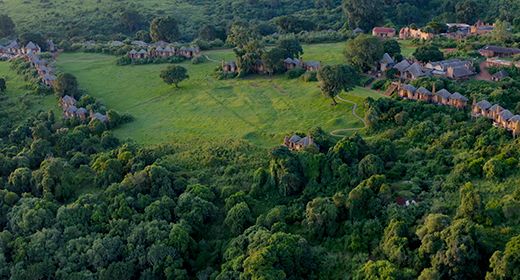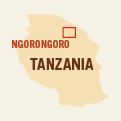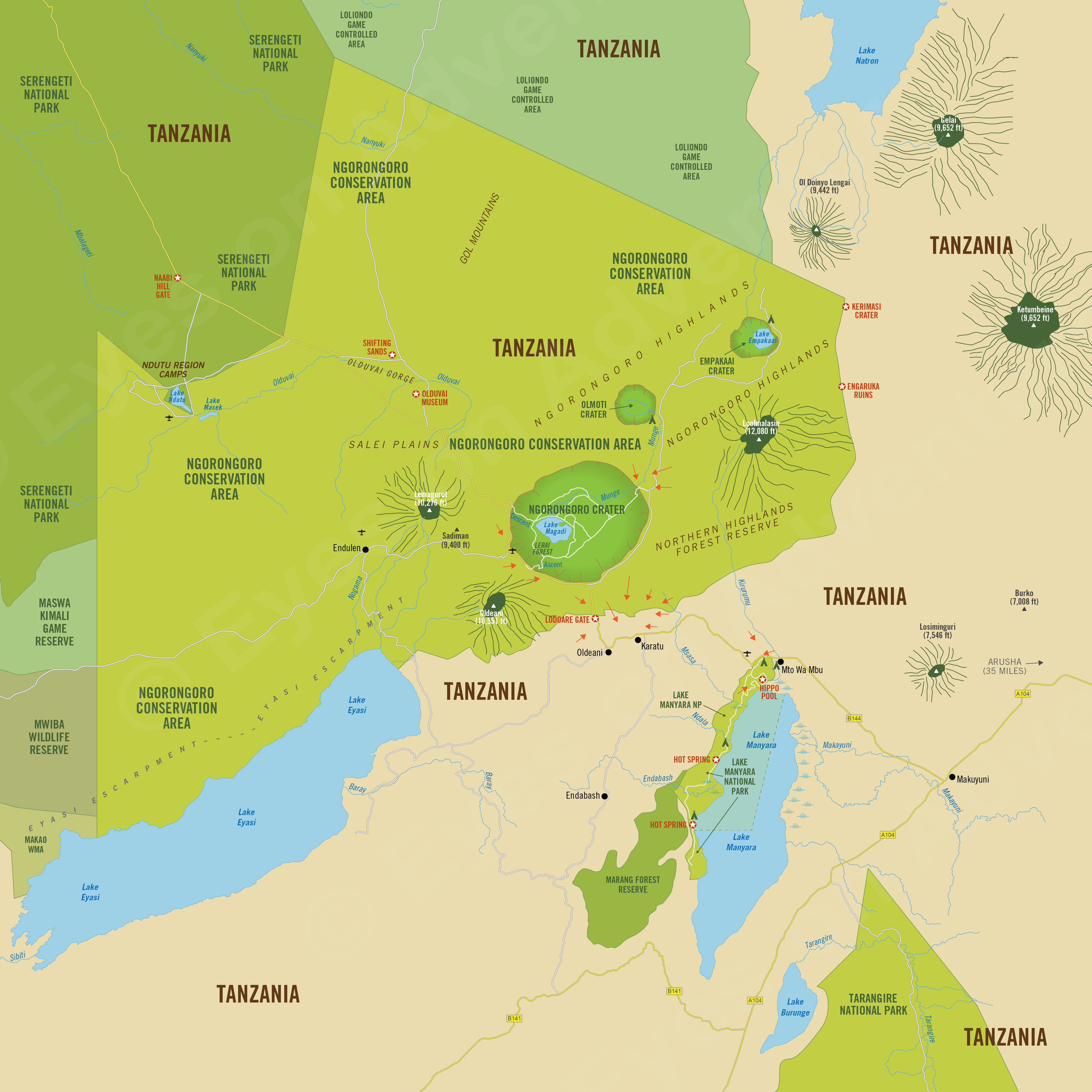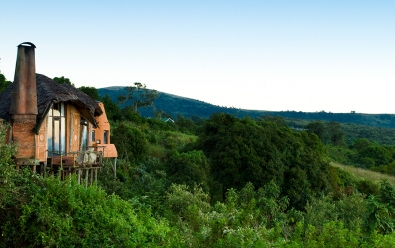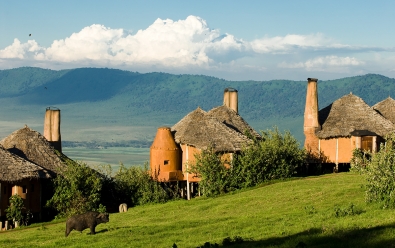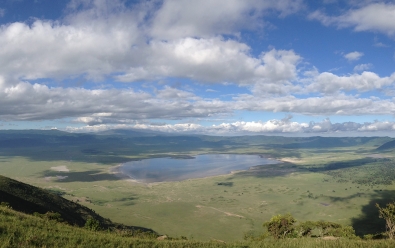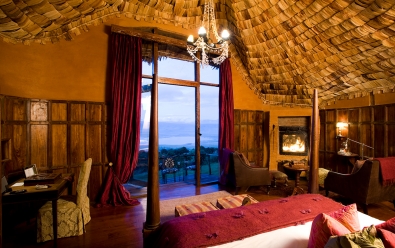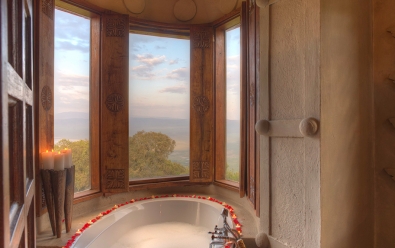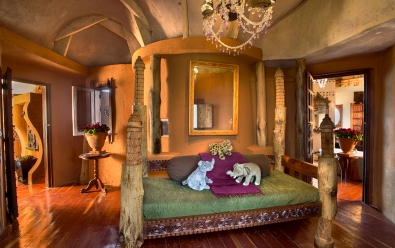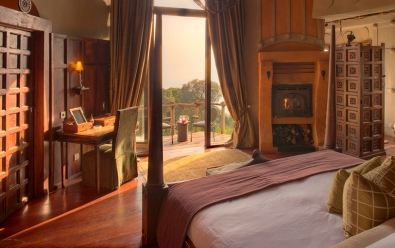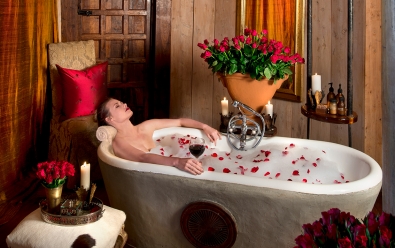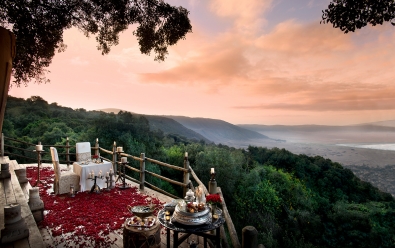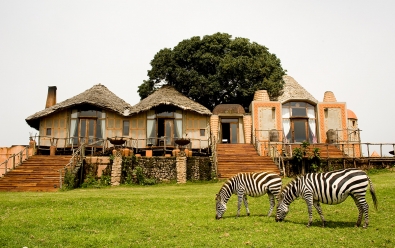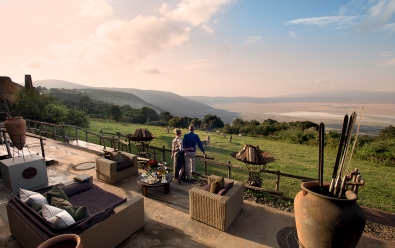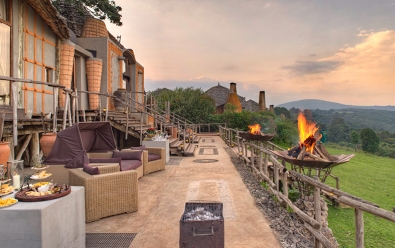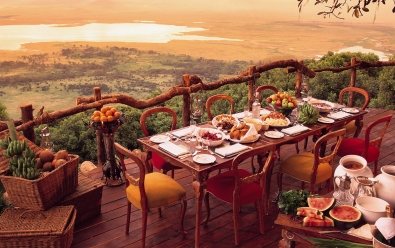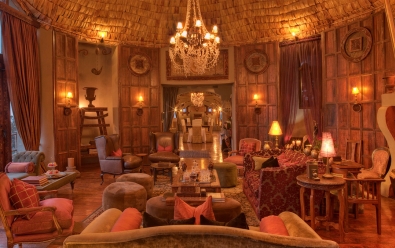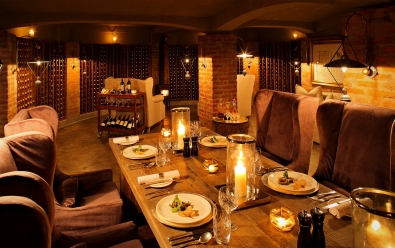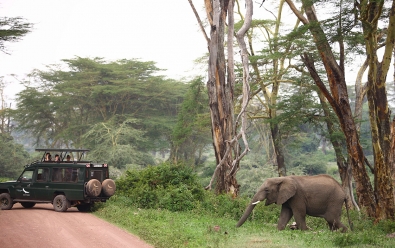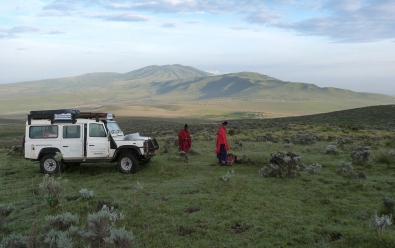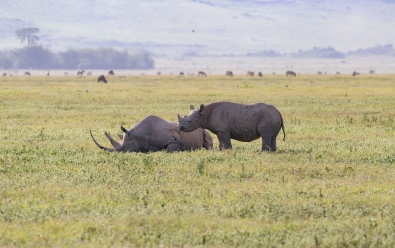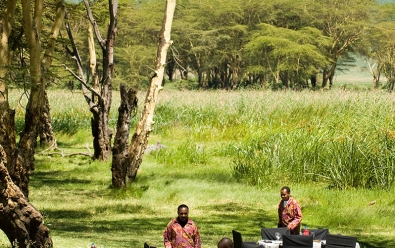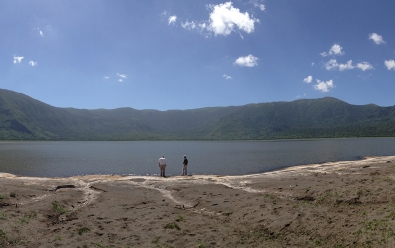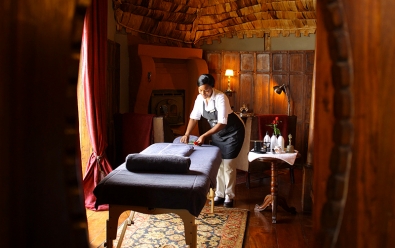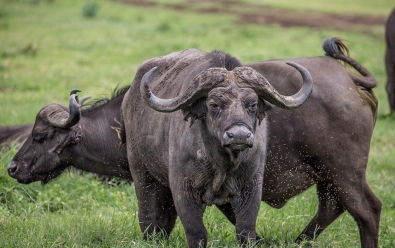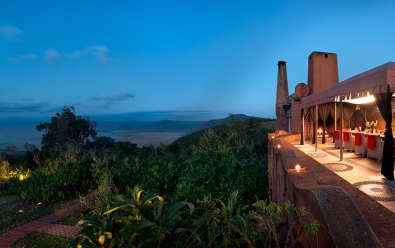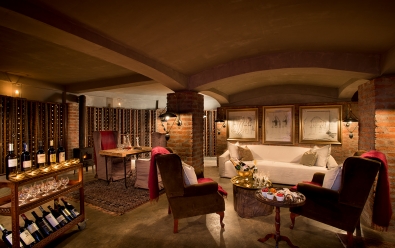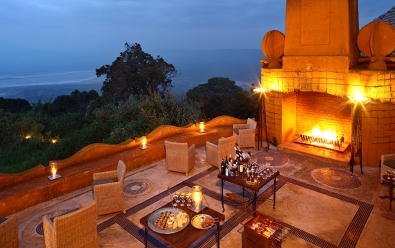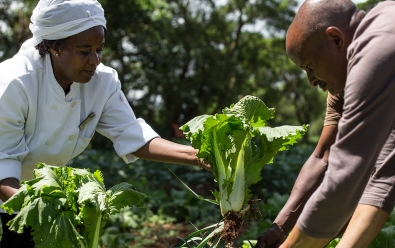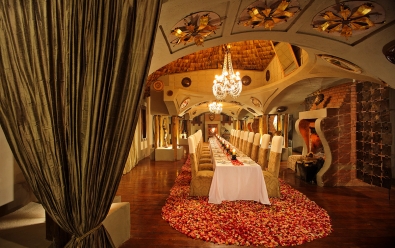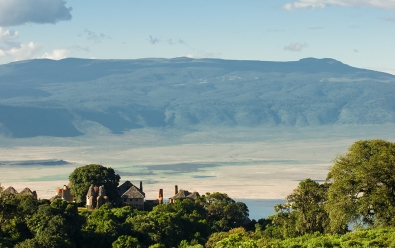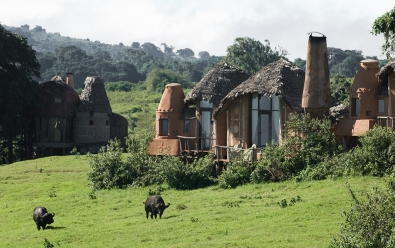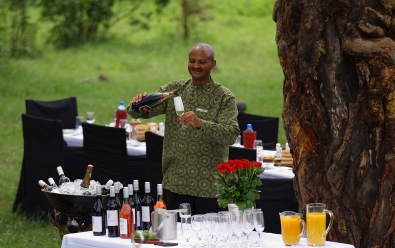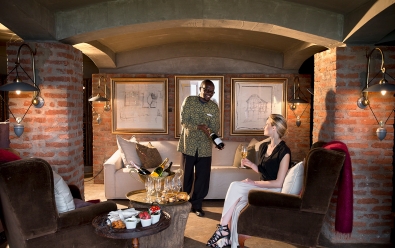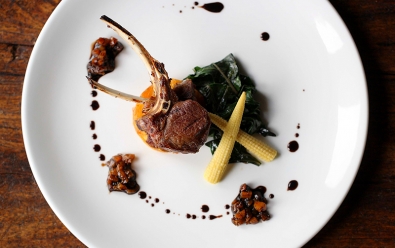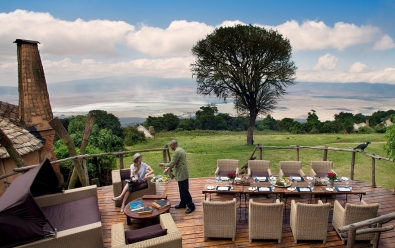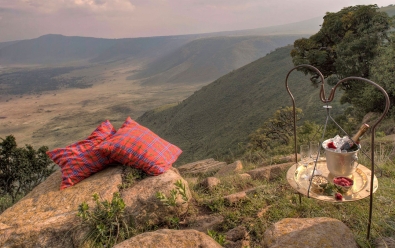Ngorongoro Crater Lodge
Inquire for lodging prices
Highlights
- Ngorongoro Crater is one of Africa's prime wildlife destinations
- Situated on the rim of the crater with sensational views
- Superb wildlife viewing in an unmatched setting
- Hiking, sightseeing, and cultural activities
Location
- Southwest rim of Ngorongoro Crater
- Ngorongoro Conservation Area
- Northern Tanzania
Crater Lodge is situated on the rim of the wildlife-rich Ngorongoro Crater, offering guests spectacular safaris and vistas into one of Africa's greatest wildlife destinations.
The Ngorongoro Crater is the world's largest intact, non-flooded caldera and is home the around 30 000 wild animals, including all of Africa's Big Five (lion, leopard, elephant, rhino, and buffalo). Safaris inside the crater offer guaranteed wildlife around every corner and the setting itself is like nowhere else on the continent.
Guest accommodations and camping out are not permitted within the Ngorongoro Crater itself, so the rim of the crater, which is 2 000 (610 meters) feet above the crater floor, and areas just outside the crater is where the safari camps and lodges are located. Each day, guests staying at Crater Lodge descend in 4x4 vehicles down into the crater to enjoy a full day wildlife safari on the crater floor. All vehicles must leave the crater before dark.
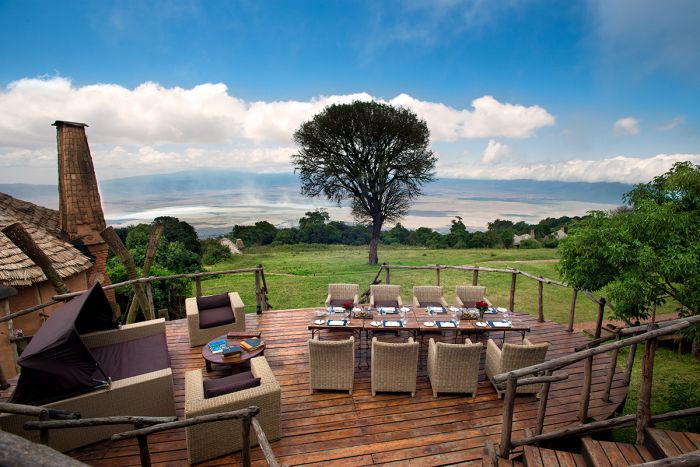
One of three main guest areas overlooking the Ngorongoro Crater.
Besides safaris in the Ngorongoro Crater itself, the Ngorongoro Highlands include other destinations that can be reached on day-trips from the lodge. There are two other smaller craters that can be explored on foot, Olduvai Gorge (also called the Cradle of Mankind), where some of the first discoveries of our earliest ancestors were discovered, and Lake Eyasi. Cultural visits to meet the local Maasai and Hadzabe people are also on offer. Guests can also spend time with the on-site KopeLion conservation project team.
Ngorongoro Crater Lodge offers 30 romantic and lavish guest suites, all perched on stilts and offering views over the crater below. The suites are adorned with antiques, chandeliers, and hand-crafted African pieces and evoke a safari from days gone by. Large floor-to-ceiling windows offer breathtaking views from inside, while private verandas do the same outdoors. Each suite includes a sitting room with a fireplace to keep the room warm during the chilly highland nights.
Two of the guest suites are connected by an interior passage which can be opened, creating a perfect double-suite that is great for a family or two couples traveling together. A limited number of rooms can also be converted to a triple.
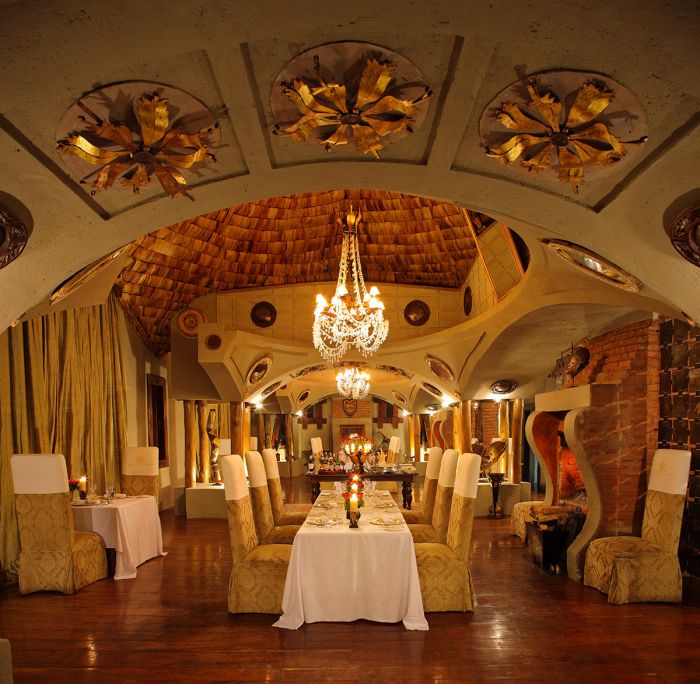
Main area dining room at Crater Lodge.
The guest suites are supported by three main guest areas, each with their own dining room, lounge, and outdoor viewing decks. Two of the main areas cater to 12 of the guest suites and the third supports the remaining 6 suites. Guests with a love of wine will enjoy the well-stocked wine cellar, which can be reserved for Champagne or wine tasting, as well as a 5-course dinner.
The grand and somewhat opulent décor at Crater Lodge has led to it being described as the place where "Maasai meets Versailles". Other facilities at the lodge include a Safari Shop, a Tanzanite Store, the 'Gorgor' sunset site, and a tree nursery. Children are welcome and the lodge offers a special WILDchild program to help keep them entertained.
Many of the the staff members at Crater Lodge are Maasai and guests will be able to enjoy learning about the Maasai culture by merely speaking to their guide. The staff are all warm and friendly and a visit to the camp will surely inspire anyone with an interest in this ancient and fascinating culture.
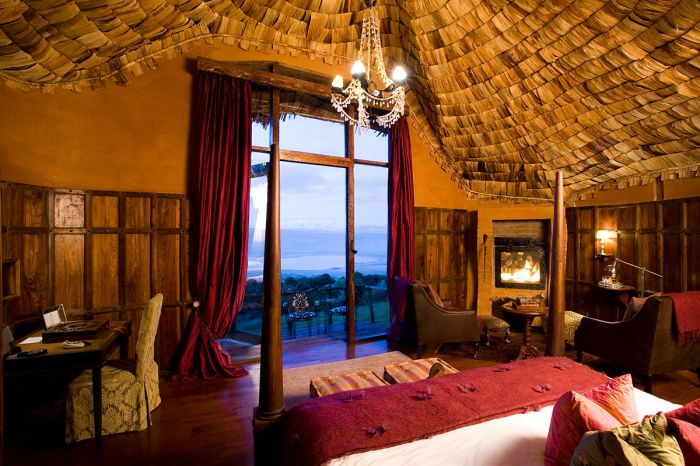
Guest suite bedroom and view.
About The Ngorongoro Conservation Area
The 3 200-square-mile (8 300-sq-km) Ngorongoro Conservation Area (NCA) is a UNESCO Biosphere Reserve (declared in 1981) and is one of Africa's most diverse regions. The NCA protects an extremely rich and diverse ecosystem that includes the volcanic highlands situated between Africa's Great Rift Valley to the east and the Serengeti Plains to the west. The Ngorongoro Crater is the highlight of the region, but there are numerous other volcanos and calderas, plus forests, plains, rivers, lakes, and fertile valleys.
The volcanic southeast portion of the NCA consists of a line of eight mostly extinct shield volcanos along the Gregory Rift Escarpment. Five of these volcanos are dome-shaped cones and three are calderas (collapsed volcanos). The Ngorongoro Crater is the largest of the calderas and is one of Africa's greatest eco-tourism destinations, with thousands of large mammals living in the crater.
Besides the Ngorongoro Crater, the NCA protects two other beautiful, albeit smaller craters: Olmoti and Empakaai. Neither can match the Ngorongoro Crater for wildlife, but both offer spectacular walking safaris into and around the craters, with almost no tourists. Both craters are easily reached from camps in the region on a day trip. The local Maasai have some small villages around these craters.
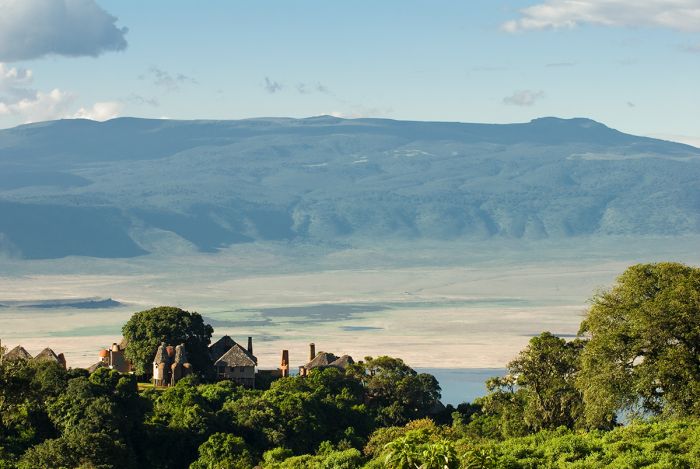
Crater Lodge on the rim of the Ngorongoro Crater.
The northwest portion of the NCA adjoins with Serengeti National Park and consists of open grasslands and plains and the Gol Mountains (consisting of inselbergs). To the west of the Ngorongoro Highlands towards the Serengeti lies Olduvai Gorge, one of the most important paleo-anthropological sites on Earth, where Mary and Louis Leakey made discoveries about the earliest hominins. The nearby Salei Plains are a hotspot for the annual Great Migration of wildebeest and zebra, which move through the NCA between December and April.
The far western part of NCA includes the Lake Ndutu Area, which is a very popular destination in the southern Serengeti plains, especially when the migration of wildebeests and zebras are present in huge numbers between December and April. Some of the camps around Ndutu are located in the Serengeti National Park while others are in the NCA.
Ngorongoro is Tanzania's most visited wildlife area, attracting some 300 000 tourists from around the world each year and it is one of Africa's must-see destinations. Many safari itineraries begin in Arusha town to the east, driving west towards the Serengeti and stopping to visit Ngorongoro (and sometimes Lake Manyara) for a few days along the way.
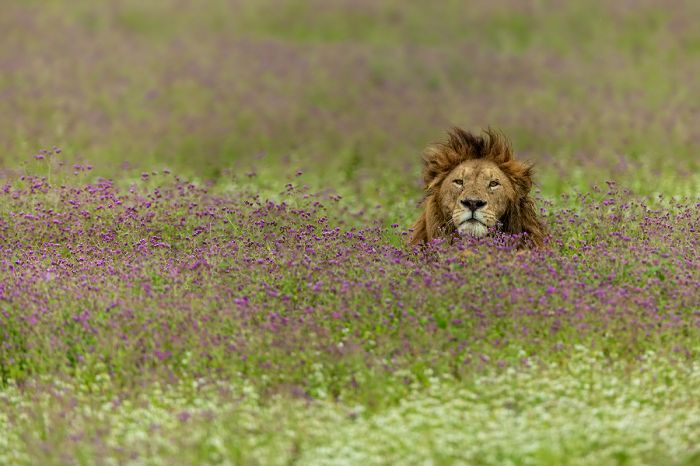
A male lion in the Ngorongoro Crater.
About the NGORONGORO CRATER
The Ngorongoro Crater was formed when an enormous volcano on the western portion of Africa's Great Rift Valley erupted and collapsed upon itself some 2.5 million years ago. The violent explosion left a 2 000-foot (610-meter) deep, 12-mile (19-km) diameter crater. The crater covers an area of 108 square miles (280 sq kms), which makes it the world's largest intact and un-flooded caldera. The height of the original volcano is estimated to have been as high as 19 000 feet (5 800 meters).
Today the Ngorongoro Crater is a haven for wildlife and home to between 25 and 30 thousand large mammals, including Africa's highest density of predators. Wildlife in the Crater includes all of Africa's Big Five (lion, leopard, elephant, buffalo, rhino), providing incredible game viewing for its daily visitors. Accommodation is not allowed within the crater, so game drives descend every morning for day-long safaris in the crater and ascend to their camps, many of which are located along the crater rim, at dusk.
The steep and busy "descent road" is usually bumper-to-bumper when the morning game drives depart down into the crater at dawn. Thick mist floats through the highland forest along the rim and upper crater wall, creating an ethereal atmosphere, with birds singing and eager tourists awaiting their first exploration into the crater. The misty forest is mesmerizing in the early morning, with ancient trees, epiphytes, ferns, orchids and tree moss.
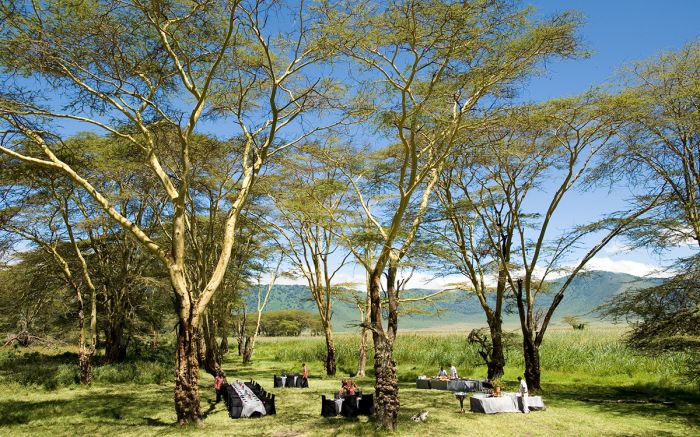
A midday banquet in the Ngorongoro Crater.
The main feature on the crater floor is Lake Magadi, a shallow soda lake which size is dependent upon recent rainfall. The lake supports huge numbers of flamingos, especially during the dry season.
Wildlife in the crater is diverse and includes all of Africa's Big Five (lion, leopard, buffalo, elephant, rhino). Four of the five are a virtual guarantee on a day-long safari, with leopard being the toughest to find. Black rhinos number around twenty individuals. Lion numbers vary between 50 and 80, while the most abundant predator in the crater is the spotted hyena, which number between three and four hundred. Both golden and black-backed jackal are present in good numbers.
The lovely Lerai Forest on the southern side of Lake Magadi consists almost entirely of yellow fever tree Acacias. The forest is home to bushbuck, waterbuck, and eland. There are also several hippo pools in the crater.
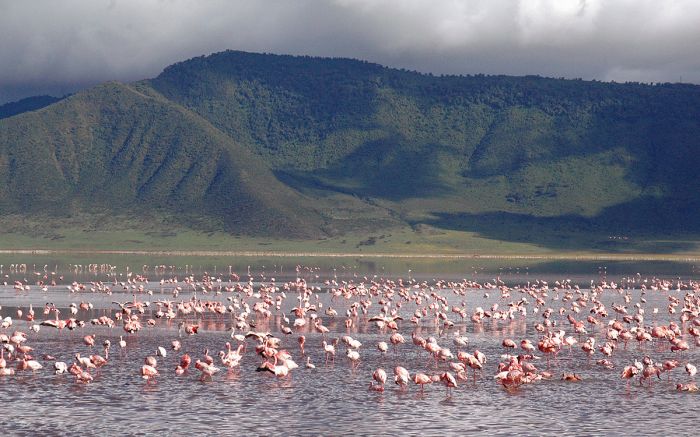
Flamingos on Lake Magadi on the floor of Ngorongoro Crater.
Open grassland covers much of the crater floor, offering ideal habitat for grazing herbivores. Wildebeest and zebra are very common, as well as smaller numbers of buffalo, Thomson's gazelle, Grant's gazelle, hartebeest, mountain reedbuck, warthog, and topi. Elephants range throughout the crater and even climb in and out entirely. Some of the country's biggest and oldest bull elephants are full-time residents. Two species absent from the crater itself are giraffe and impala, although the occasional giraffe has been known to visit the crater, but they never stay long.
Birding in the crater is very good, with flamingos often found on Lake Magadi, as well as abundant water birds in the swamp areas. The kori bustard is commonly seen, as are ostrich and several species of vulture. Over 280 species of bird have been recorded in the crater.
Strict adherence to the crater's game drive rules are enforced and there is no off-road driving. Visitors must stay in their vehicles except at designated picnic spots.
ROOMS INCLUDES & EXCLUDES CHILDREN FACILITIES ACTIVITIES
Accommodation
30 guest accommodations in total comprising:
- 30 stilted suites, each with two three-quarter beds (separate mattresses with shared base). Mattress converters are available that transform the twin beds into a double bed. Four of the suites are available as a triple (adult(s) and children 16 years and younger).
- Suites 1 and 2 are connected by an enclosed inter-leading foyer, which allows easy access between the suites while maintaining complete privacy. When combined as a double suite, this is ideal for a family or even two couples traveling together. When used by a family with children, the double suite can accommodate two adults and two children (three children can be provided for on request).
All of the suites are constructed of earthen mortar and wood, with banana-leaf ceilings and thatched roofing. The suites are adorned with lovely antiques and elegant African décor.
Every suite includes en-suite facilities with two, separate single-basin vanities, indoor shower, bathtub, and separate toilet. The lavish suites are accessed via footpaths on the ground leading to the main camp area.
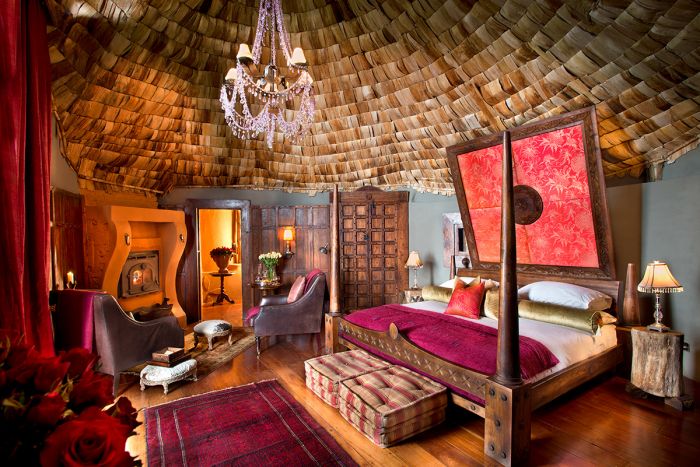
Guest suite bedroom at Ngorongoro Crater Lodge.
The suites are arranged around three main camp areas (each having its own dining, lounge, and bar area) and perched on the edge of the Ngorongoro Crater rim. The suite bedrooms, sitting rooms, and bathrooms all have floor-to-ceiling glass windows, offering spectacular vistas over the crater below.
Beaded chandeliers hang above large gilt mirrors, while antiques, billowing raw silk curtains and leather-backed chairs blend harmoniously with African art elements. En-suite bathrooms with a dramatic centerpiece of red roses feature spacious showers and chandelier-lit bathtubs.
Personal butlers discretely cater for each guest’s every need, bringing tea in bed, stoking fireplaces and drawing luxurious bubble baths.
Other items and features in the guest suites include:
- Private veranda overlooking the Ngorongoro Crater.
- Wood fireplace in the sitting area.
- Mini-bar and fridge.
- Tea / coffee station.
- Gym-in-a-basket.
- Healing Earth treatments offered in-room.
- Complimentary pair of Swarovski binoculars (one per cottage).
- In-room Wi-Fi (not available in main guest areas).
- Telephone (intermittent GSM mobile reception).
- Hairdryer.
- In-room safe.
Ngorongoro Crater Lodge can accommodate a maximum of 64 guests in total: 2 persons in each of the 30 guest cottages with four suites covetable to a triple to accommodate a child 16 years and younger.
Includes & Excludes
Includes:
- All meals and local beverages including soft drinks, house wines, local brand spirits and beers, teas, and coffees.
- Safari experiences (game drives into the Ngorongoro Crate, nature walks within the lodge grounds, and birding) accompanied by an experienced guide.
- WILDchild program for kids.
- Laundry services are provided on a daily basis (weather permitting, items will be returned on the same day). Laundry is dried by the sun and on most days any laundry placed out in the morning will be returned by the evening.
- A complimentary pair of Swarovski Optik CL Companion 8×30 binoculars per cottage for use during your stay.
- Emergency medical evacuation insurance.
- Wi-Fi access.
- Tourism Levy & VAT.
Excludes:
- Certain premium activities (read more below in the activities section).
- Purchases from the Safari Shop.
- Champagne, cognacs, fine wines, premium brand spirits, and cigars.
- Healing Earth wellness treatments.
- Any applicable wildlife fee, park fee, reserve fee, concession fee, other land-use fee.
Single Supplement
A single supplement may apply for any room booked by a single traveler; please ask us for pricing.
Children
Families can rest assured that your children will always be safe and well cared for (both during activities and at the camp) by the camp staff.
Children of any age are accommodated at Ngorongoro Crater Lodge:
- 1 double / family suite (two suites with an inter-leading foyer) accommodating 2 adults and 2 children (can be 3 children on request). The family suite is located in North Camp.
- 4 suites can be made into a triple (third must be a child under 17 years).
- Children under the age of 6 years are permitted only on a private vehicle or a children’s game drive (avoiding lion, leopard and elephants sightings), not during standard game drive time. No walks outside of the camp.
- Children aged 6-11 years are permitted on game drives at the discretion of the manager and guides (private vehicle required).
- Children aged 6-11 years are not permitted on nature walks outside of the camp grounds.
- Children aged 12-15 years are permitted on game drives (private vehicle required) and nature walks.
- Private vehicle not required for children aged 16 years and older.
- Children aged 16 and above are permitted on specialist walking safaris.
- Children that share a vehicle with other guests not in their party may be subject to activities only at the camp manager’s discretion.
- Please note: The camp is not fenced off and children are required to have an adult accompanying them at all times.
- While the camp does not have trained child minders, it can offer the services of certain staff members who are wonderful with children. This will be at an additional cost (best to pre-book this with us).
AndBeyond’s WILDchild programme, designed especially for children aged 3-12 years, is filled with fun, interactive activities that offer opportunities to learn and discover new experiences and cultures. Deeply rooted in the love for the African bush, it not only creates a series of unforgettable moments for the whole family, but forges strong bonds between young guests, our planet, and its people.
Wildchild activities include:
- Wood carving (with 'Carver Dullah’ in his workshop).
- Tree planting in the tree nursery.
- Bead work with the Maasai mamas.
- A bow-and-arrow adventure.
- Baking cupcakes with the lodge’s chefs.
- A game of soccer with the Buffalo Team, the lodge’s official soccer team.
Facilities
Situated in a spectacular setting on the edge of the Ngorongoro Crater's rim, the lodge has three main guest areas (North Camp, South Camp, Tree Lodge), each with its own dining room, kitchen, lounge area, bar, and outdoor viewing deck. Two of the camps (North Camp, South Camp) cater to 12 suites each, while the third (Tree Lodge) caters to 6 suites.
The opulent main guest areas are steeped in romance and evoke the atmosphere of a bygone era, making it easy to understand how the lodge has been described as "Maasai meets Versailles".
Main guest area facilities include:
- Three main guest areas for dining and gathering.
- Safari Shop (centrally located).
- Tanzanite Store (centrally located).
- Wine Store (located at North Camp).
- Tree Nursery (centrally located).
- 'Gorgor' sunset site (can be booked for private use).
- Guest toilets in main areas.
- Wi-Fi available in guest suites only.
- 24-hour electricity.
Activities
Activities included in the rate:
- Full-day safari drives (in the Ngorongoro Crater) in semi-open 4x4 Land Cruisers (4-seater).
- A complimentary pair of Swarovski Optik CL Companion 8×30 binoculars per guest cottage for use during your stay.
- Nature walks on the lodge grounds.
- Birding.
- WILDchild program for kids.
Optional activities at additional cost:
- Private activities are on offer (subject to vehicle availability, which needs to be booked in advance).
- Ngorongoro Crater floor banquets.
- Day trips to Olduvai Gorge and Shifting Sands.
- Crater View Walk (1-2 hours).
- Lake Eyasi Walk (Half-day, maximum 6 hours).
- Empakaai Crater Hike (full day with a picnic lunch in the crater).
- Champagne tasting, wine-pairing dinner, private 5-course dinner in the wine cellar.
- Cultural visit to a Maasai boma.
- Cultural visit to the Hadzabe people near Lake Eyasi.
- KopeLion conservation experience (must be booked in advance and includes a donation to the project).
- Wellness treatments (offered in-suite).
Example of a typical day:
- Early morning wake-up call.
- Light breakfast before departing for descent into the Ngorongoro Crater.
- Full-day safari drive in the crater with stops for refreshment and lunch.
- Ascend back up to the lodge on the crater rim.
- Freshen up or meet for drinks, followed by dinner.
- Enjoy a nightcap and/or discussion at the bar, in the lounge or on the outdoor deck before retiring.
Great Good Fair Poor
- Jan
- Feb
- Mar
- Apr
- May
- Jun
- Jul
- Aug
- Sep
- Oct
- Nov
- Dec
GENERAL TIPS
The Ngorongoro Crater offers excellent wildlife viewing all year, as its unique ecosystem means that most of the wildlife stays in the crater throughout their lives, so the animals are in effect living in an enclosed environment.
Similar to the Serengeti region just to the west, it is advised to avoid the Ngorongoro region over March and April, when heavy rains typically occur. June to mid-October is excellent for general game viewing in the Crater in terms of the wildlife and the weather.
Ngorongoro Crater Lodge is open year-round.
RAINS
The rainy season in northern Tanzania is from November thru mid-May, with two distinct rain seasons. The "Short Rains" (locally called the "mvuli") fall from mid-November to mid-December and are generally lighter and less impactful to safari activities. The "Long Rains" (locally called the "masika") occur between March and May, brining afternoon showers on a near daily basis.
Short Rains
The short rains occur for about one month sometime during November and December (the exact time varied somewhat year to year). This period is called the 'short' rains because the duration of an individual rain event is short and it is rare to have an all-day rain event. Most rain falls as an afternoon shower, while mornings are typically overcast or clear.
Long Rains
The long rains occur between March and May, with April being the wettest month of the year. During this time, rain should be expected almost every day and the showers can last for hours at a time, although all-day rain is not typical. The roads into and out of the Ngorongoro Crater can be quite difficult during the long rains, which can mean longer times getting in and out. Cloudy skies are typical and temperatures can be chilly at times.
The period between the short and long rains (January and February) also receives rainfall, but many days are clear and the amount and duration of the rain events is unpredictable, with some afternoon showers and the odd long and heavy shower.
TEMPERATURES
The temperatures in the Ngorongoro do not experience wide fluctuations throughout the year, as the region lies between one and three degrees south of the equator. In general, daytime temperatures are comfortably warm and overnights and early mornings are chilly. Bring a fleece and rain jacket regardless of the timing of your visit.
Ngorongoro's climate is generally mild, but temperatures in the Ngorongoro Highlands, including the camps and lodges at the Ngorongoro Crater, are heavily influenced by their higher elevations. Temperatures around the crater experience chilly to cold nights, so be prepared with appropriate attire. The Ngorongoro Crater rim (7 500 feet / 2 286 meters) and the Crater floor (5 500 feet / 1 676 meters) are at much higher elevations than the vast plains of the Ngorongoro Conservation Area to the west.
Conditions inside the Ngorongoro Crater are pleasant during the day when game drives are allowed, with temperatures averaging 68-73°F (20-23°C). Accommodations for the crater are up on the rim or further outside the caldera, where nighttime temperatures drop significantly and can approach freezing in the dry season (Jun-Oct) and average 42°F (5°C) during the rainy season (Nov-May).
THE GREAT MIGRATION
The annual movement of wildebeest and zebras across the Serengeti-Masai Mara ecosystem is one of the greatest spectacles in the natural world. These large herds move in a circular track across southern Kenya and northern Tanzania, taking a full year to complete their cycle. The migration moves across both the Greater Masai Mara (in Kenya) and the Greater Serengeti (in Tanzania) in a fairly consistent pattern and timeframe. The animals move to take advantage of fresh grasses on which to graze.
The migrating herds of roughly 1.5 million blue wildebeests and several hundred thousand plains zebras spend about nine months of the year moving through Tanzania's Greater Serengeti (which includes the Ngorongoro region) and the other three months in Kenya's Greater Masai Mara.
The migrating herds are in Tanzania's Greater Serengeti from sometime in October until around late-July (note that the timing is never precise and varies somewhat year to year). Note that the Greater Serengeti is vast, and it is important to note where in the region the herds are located during this nine-month timeframe.
The large herds of animals in the Great Migration usually cross into the Serengeti from Kenya's Masai Mara sometime around early October and move north back into Kenya around mid- to late-July.
Most of the migration stays west of the Ngorongoro Highlands, where thousands of animals move through the western portion of the Ngorongoro Conservation Area, especially around Lake Ndutu, where they spend the months of December thru April. Wildebeest calving occurs in the southern Serengeti and Ndutu area in February.
There are numerous safari camps that are set up on a seasonal basis to best see the migration throughout the Greater Serengeti, including the Lake Ndutu Area.




